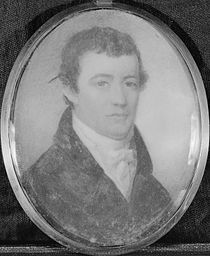| Elias Horry | |
|---|---|
 | |
| 22nd Mayor of Charleston | |
| In office 1815–1817 | |
| Preceded by | Thomas Rhett Smith |
| Succeeded by | John Geddes |
| In office 1820–1821 | |
| Preceded by | Daniel Stevens |
| Succeeded by | James Hamilton Jr. |
| Member of the South Carolina House of Representatives from St. James, Santee Parish | |
| In office 1794 – 1804 | |
| Member of the South Carolina House of Representatives from Charleston | |
| In office 1830 – 1833 | |
| President of the South Carolina Canal and Railroad Company | |
| In office 1831-1843 | |
| Succeeded by | Railroad merged |
| Personal details | |
| Born | June 21, 1773 Charleston, South Carolina |
| Died | September 17, 1834 Charleston, South Carolina |
| Spouse(s) |
Harriet Vanderhorst (m. 1797) Mary R. Shubrick (m. 1817) |
| Children | 7 |
| Profession | Lawyer, planter, businessman |
Elias Horry (1773 – September 17, 1834) was a lawyer, politician, businessman and plantation owner who twice served in the South Carolina General Assembly as well as the intendant (mayor) of Charleston, South Carolina, serving two terms from 1815 to 1817 and 1820 to 1821.
Early and family life
Horry was born in 1773 and received a private education suitable for his class. He joined Charles Cotesworth Pinckney's office as a law student.
He married twice. In 1797 he married Harriet Vanderhorst, who bore three sons and two daughters before her death: Thomas Lynch Horry (1806–1871); Harriet Vanderhorst Horry Frost (1807–1890); Ann Branford Horry (1812–1824) and Elias Horry (1815–1817). The widower then married Mary R. Shubrick in 1817, who bore Alicia Mary Horry (1820–1826); Elias Horry (1822–1839); and Richard Shubrick Horry (1823–1824).
Career
In 1793, Horry was admitted to the South Carolina bar. He represented St. James, Santee, in the South Carolina General Assembly from 1794 to 1804.
Horry was elected warden (city council member) in September 1813 before becoming the interim intendant (mayor) on March 30, 1815, after Thomas Rhett Smith resigned. On September 18, 1815, he was elected to a full term and then re-elected September 16, 1816, defeating Daniel Stevens. After four terms by two other mayors, Horry returned to the position, after having been elected on September 4, 1820, for one more term.
Many years later, he again served in the South Carolina House of Representatives, representing the Charleston area from 1830 to 1833.
Horry owned several plantations which he operated using enslaved labor, including: The Bluff, Wattahan, Milldam, Jutland, Camp Main, Camp Island, Newland, Midland and Millbrook plantations (Santee River) in Georgetown District and St. James, Santee, Parish.

Horry became president of the South Carolina Canal and Railroad Company in 1831.
Death and legacy
Horry died on September 17, 1834. He is buried at the Cathedral of St. Luke and St. Paul in Charleston, South Carolina. The Branford-Horry House in which he was raised and later lived in Charleston was placed on the National Register of Historic Places in 1970, and remains in private ownership.
References
- "At a quarterly meeting . . ". The Southern Patriot. Charleston, South Carolina. October 17, 1834. p. 2. Retrieved January 25, 2014.
- "Elias Horry, Esq. . . ". City Gazette and Daily Advertiser. Charleston, South Carolina. April 1, 1815. p. 3. Retrieved January 25, 2014.
- "Elias Horry, Esq. . . ". City Gazette and Daily Advertiser. Charleston, South Carolina. September 17, 1816. p. 2. Retrieved January 25, 2014.
- "An election for Intendant . . ". City Gazette and Daily Advertiser. Charleston, South Carolina. September 16, 1816. p. 2. Retrieved January 25, 2014.
- ^ "Elias Horry". Preservation Society of Charleston. Archived from the original on February 2, 2014. Retrieved January 25, 2014.
- Smith, Alice R. Huger; Smith, D.E. Huger (2007). The Dwelling Houses of Charleston. Charleston: The History Press. p. 60. ISBN 9781596292611.
- "1750s colonial with exquisite original details asks $6.2M in Charleston". 7 February 2018.
| Preceded byThomas Rhett Smith | Mayor of Charleston, South Carolina 1815–1817 |
Succeeded byJohn Geddes |
| Preceded byDaniel Stevens | Mayor of Charleston, South Carolina 1820–1821 |
Succeeded byJames Hamilton Jr. |
- Mayors of Charleston, South Carolina
- 1773 births
- 1834 deaths
- South Carolina lawyers
- Members of the South Carolina House of Representatives
- 19th-century American lawyers
- 19th-century mayors of places in South Carolina
- 18th-century members of the South Carolina General Assembly
- 19th-century members of the South Carolina General Assembly